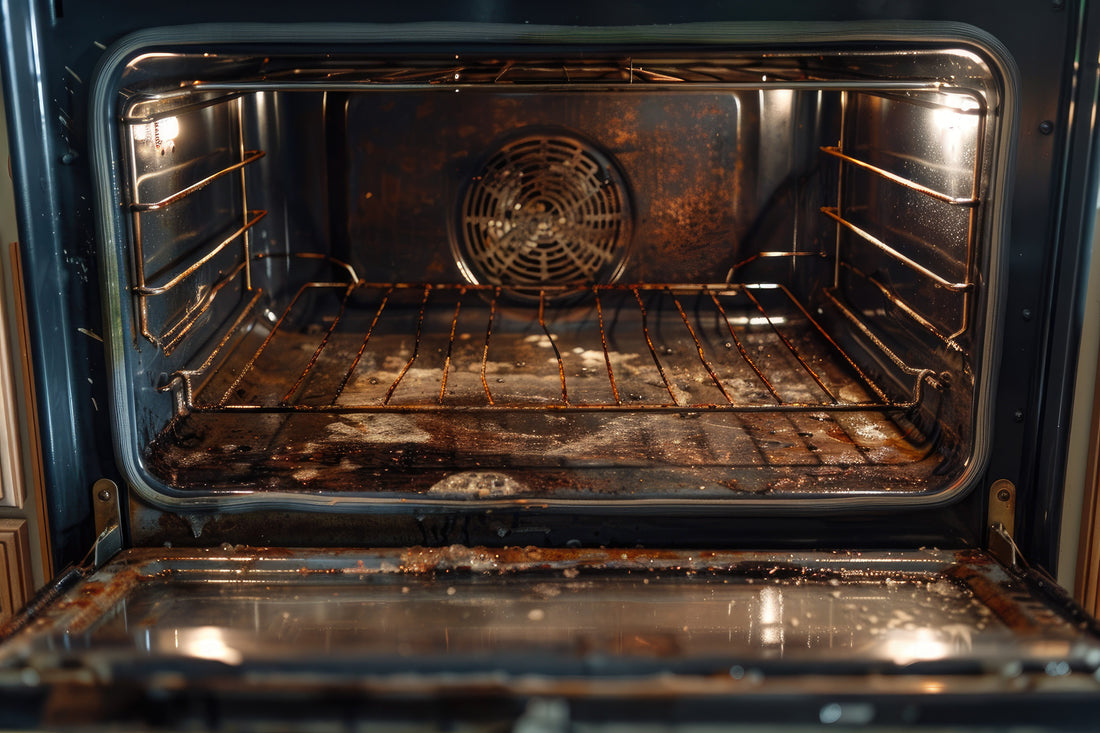Rust in microwave is primarily caused by moisture accumulation and the breakdown of the interior coating. Several factors contribute to rust formation:
Moisture Accumulation from Food Splatter
When food is heated, it often splatters or releases steam, which can settle on the microwave’s metal components. Over time, the trapped moisture creates the perfect environment for rust to form, especially if the microwave isn’t cleaned regularly.
Improper Cleaning Habits
Using harsh cleaning tools, such as abrasive scrubbers or steel wool, can scratch the protective enamel coating inside the microwave. Once the coating is damaged, the exposed metal is more vulnerable to moisture leading to rust. Furthermore, neglecting to wipe down food splatters after each use can allow moisture to linger inside the microwave, accelerating the rusting process.
Damaged Interior Coating
The interior coating of a microwave is designed to protect the metal from rust and other damage. However, if the coating becomes chipped or worn out due to constant cleaning or heavy use, moisture can penetrate and cause rust formation.
Is It Safe to Use a Microwave with Rust Inside?
Using a microwave with rust inside poses several safety concerns, which should not be overlooked. While the presence of rust may seem like a minor issue, it can affect the appliance’s integrity and lead to potential risks.
Radiation Leakage
Rust can damage the protective coating inside the microwave, which shields you from harmful radiation leakage. Over time, rust weakens the appliance’s structure, and if left untreated, it can lead to radiation leakage, which may be harmful to your health.
Food Contamination
Rust flakes can dislodge from the interior and mix with the food being heated, leading to food contamination. These rust particles are not safe for consumption and may cause a range of health issues if ingested, especially when exposed to high heat.
Electrical Hazards
Rust inside a microwave can interfere with its electrical components, causing electrical hazards. Rust buildup on wires or metal components can lead to short circuits or even fires if the rust affects the microwave’s electrical performance.
How to Remove Rust from Microwave Interior?
If you notice rust inside your microwave, it’s important to address it promptly to ensure the appliance remains safe and functional. Here’s a step-by-step guide to help you remove rust from the microwave interior:
Unplug the Microwave: Before starting any cleaning or rust removal process, always unplug the microwave to ensure safety.
Clean the Interior: Start by cleaning the microwave interior to remove any food splatters or debris. Use a soft cloth and a mild cleaning solution (baking soda and water or vinegar and water). Wipe the surface gently to avoid further damaging the interior coating.
Apply Baking Soda Paste: For rust removal, create a paste by mixing baking soda with a small amount of water. Apply the paste directly to the rusted areas. Let it sit for about 15-20 minutes to loosen the rust.
Use Sandpaper or a Scrub Pad: Gently sand the rusted areas using fine-grit sandpaper or a non-abrasive scrub pad. Be careful not to scratch or damage the interior surface. Lightly scrub the affected area until the rust is removed.
Apply Microwave-Safe Paint: If the rust has caused visible damage to the coating, consider applying microwave-safe appliance epoxy or paint. Ensure the product is specifically designed for use in microwaves to withstand heat and moisture.
Reassemble and Test: Once the rust is removed, allow the microwave to dry completely before using it again. If you’ve applied paint, ensure it is fully cured as per the manufacturer’s instructions.
Preventing Rust in Your Microwave
Preventing rust in your microwave is essential to maintain its performance and extend its lifespan. Here are some practical tips for rust prevention and effective microwave care:
Regular Cleaning
One of the best ways to prevent rust is by maintaining good cleaning habits. Wipe the interior after every use to remove food splatters and moisture. Use a soft cloth and a mild cleaning solution like a mixture of baking soda and water. Avoid abrasive materials that can scratch the interior coating, as these can expose metal surfaces to moisture.
Control Moisture
Moisture control is key in preventing rust formation. After using the microwave, leave the door open for a few minutes to allow any trapped moisture to evaporate. Avoid using the microwave with excessively wet items or containers, as this can lead to moisture buildup inside the microwave.
Use Microwave-Safe Containers
Always use microwave-safe containers to avoid spills that can cause moisture buildup. Containers that aren’t microwave-safe may warp, leak, or create excess moisture, increasing the risk of rust inside the microwave.
Check the Interior Coating
Periodically inspect the microwave’s interior for any signs of wear or damage to the coating. If you notice any chips or cracks, address them immediately to prevent rust from forming on exposed metal surfaces.
When to Replace a Rusty Microwave
Deciding when to replace a rusty microwave rather than repairing it depends on several factors, including the severity of rust damage, the appliance condition, and safety concerns. Here’s when you should consider replacing your microwave:
Rust Severity
If the rust has spread extensively and caused significant damage to the interior or metal components, it may be more cost-effective to replace the microwave. Rust that has penetrated deeply can compromise the microwave’s performance and safety, making repairs difficult or ineffective.
Appliance Condition
Consider the overall condition of the microwave. If the appliance is old, inefficient, or showing other signs of wear and tear, it may be better to invest in a new one rather than repairing a rusty unit. Replacing an old microwave can save you money in the long run by improving efficiency and avoiding further repair costs.
Repair Costs
If the cost of repairing the rust or replacing damaged components is close to or exceeds the price of a new microwave, replacement becomes the more cost-effective option. Repairs may also require professional help, adding additional costs.
Safety Concerns
If rust has caused electrical issues or compromised the microwave's ability to safely contain radiation, replacement is crucial. Safety should always be the priority, continued use of a compromised microwave could lead to potential health risks.
Conclusion
Preventing rust in your microwave is crucial for its safety and longevity. Regular cleaning, moisture control, and proper care can help avoid rust formation. If rust does appear, timely removal is essential, but if the damage is extensive or compromises safety, replacing the microwave may be the best solution to ensure continued performance and safety.









